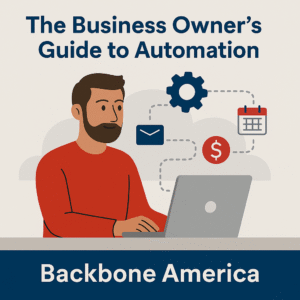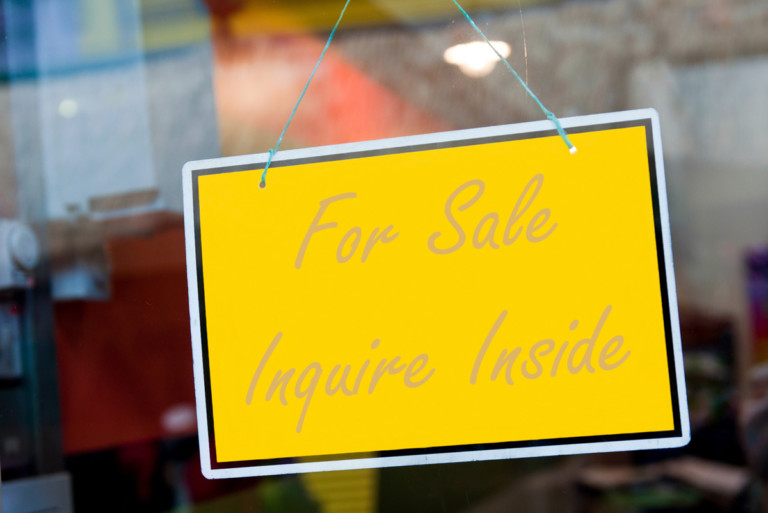Workflow Wednesday
Before I ever called it process design, I just called it burnout.
Back when I first started Backbone America, I was constantly chasing tasks. One minute I was updating a sales page, the next I was replying to DMs, then bouncing over to format an email or fix a broken link. It felt like I was working all the time, but never getting ahead.
That’s the trap no one warns you about. Not the effort—it’s the switching. The mental gear-shifting. The way one small distraction derails your whole day.
When I was interviewing for my current role as a Business Process Automation Engineer, one of the panelists asked me about my biggest weakness. I didn’t even hesitate. Multitasking. I’m awful at it. When I switch between tasks, I lose momentum. I do best when I can focus on one thing, push it through to completion, and then move on. That’s where I actually thrive.
It took me a while to realize this wasn’t just a personal quirk—it was a clue. If I kept jumping between tasks, it wasn’t always because I lacked discipline. It was because my business lacked design. Without clear processes, I had no structure to rely on—so everything defaulted to me reacting in the moment.
And that’s where process design comes in. It’s not just about getting organized or using the right tools. It’s about designing the flow of your work so it supports your strengths instead of draining them.
If you hate wasting time as much as I do? It starts here.
What Process Design Actually Means
 A lot of people think process design is about having a tool. A fancy app. An automation platform. A step-by-step checklist that promises to save the day.
A lot of people think process design is about having a tool. A fancy app. An automation platform. A step-by-step checklist that promises to save the day.
But that’s not what it really is.
Process design is about intention. It’s the part where you pause before diving in and ask:
What’s actually supposed to happen here?
What’s the outcome I’m aiming for?
What needs to happen—and in what order—for this to go smoothly every time?
Before I touch any tool—Zoho Flow, Zapier, a Zoho integration, whatever—I map the process. Not the tech. The flow. Who’s involved. What triggers what. What happens if someone forgets to follow through. What should be automated and what still needs a human touch.
That’s process design. It’s the architecture that keeps your business from feeling like a game of whack-a-mole.
Here’s what that looked like for me:
In the early days, every new lead I got was handled manually. I’d copy their info into Zoho CRM, draft a custom email, maybe follow up—if I remembered. There was no structure, no consistency. Just me winging it every time.
Now? There’s a mapped-out process. A form triggers a CRM update. That update launches a sequence. The follow-up happens even when I forget. It’s not magic—it’s design.
And here’s the difference: instead of spending my brainpower remembering what to do, I can spend it actually doing the work that moves things forward.
The Real Cost of Not Designing Your Processes
You don’t always notice the cost at first.
It starts small—answering a client email later than you meant to. Forgetting to send a follow-up. Getting halfway through a task before realizing you missed a step and need to backtrack. None of it feels urgent in the moment. But together? It adds up.
Before I started designing my processes intentionally, everything felt heavier than it had to be. I’d spend 20 minutes hunting down a file I knew I’d uploaded somewhere. I’d duplicate work—not because I forgot I’d done it before, but because I had to redo it. The first version didn’t work quite right. The process I followed was too messy, too manual, or too incomplete. So I’d circle back, revise it, sometimes even start over from scratch just to get it to a place that felt functional.
And here’s what I realized:
When your processes are a mess, your confidence takes a hit.
You second-guess yourself. You hesitate to bring on help because you’d have to explain everything from scratch. You delay launching offers—not because they’re not ready, but because your systems aren’t. That delay? It doesn’t just cost time. It costs trust. Momentum. Revenue.
It’s tempting to think you can just figure it out as you go. But the longer you wait to build a real structure, the more everything stays in your head—and the more your business depends on you remembering everything.
That’s not a sustainable strategy. That’s survival mode disguised as unnecessary hard work.
How I Started Designing Processes That Worked
 I didn’t always think in processes. I used to think in tasks.
I didn’t always think in processes. I used to think in tasks.
I’d wake up, write out a to-do list, and try to get through as much of it as possible before the day ran out. And when things fell through the cracks—which they always did—I piled it onto the next day. After a while, the list stopped helping me feel organized and started making me feel behind. Every unchecked box was a reminder that I couldn’t keep up.
That’s the kind of hidden weight we carry when our systems don’t support us.
It wasn’t until I became a Business Process Automation Engineer that something shifted.
I was building workflows, identifying bottlenecks, mapping entire approval paths—and it hit me: these skills weren’t just useful in government and corporate world. They were exactly what my business had been missing all along.
I had built Backbone America years earlier, but I hadn’t known how to scale it. Marketing felt scattered. Launches were chaotic. Even the good ideas got buried under manual work. But now I had a new lens. I could see what was broken—and how to fix it.
So I started small.
I mapped out simple flows:
What kicks off the process?
What happens next?
Where do decisions need to be made?
What tools do I already use that could handle this?
In a small business, working lean isn’t a preference—it’s survival. Corporations may have millions to throw at complexity, but I didn’t. Still don’t. That meant building processes that were clear, cost-efficient, and sustainable.
I also took note of what not to do. At work, I’d seen the headaches caused by Frankensteined systems—tools pieced together to fill a gap but weren’t meant to withstand the test of time. I didn’t want that. I wanted purpose-built flow. So I made a decision: my CRM would be the source of truth. If something touched a client—lead, campaign, booking—it would start or end in the CRM. Period.
So when I redesigned my lead follow-up, I kept that in mind:
A Zoho Form captures the lead and feeds it directly into Zoho CRM.
Zoho Campaign pulls those leads from the CRM for onboarding or nurturing.
Bookings syncs to CRM so client activity stays unified.
That’s process design. Not just automation for automation’s sake—but smart, intentional flow that respects your time and your tools.
It wasn’t flashy. It was repeatable. It gave me fewer tabs to open, fewer handoffs to worry about, and more time to focus on the work that mattered.
That’s what process design gave me: not perfection, but a rhythm I could rely on. A way to preserve my energy for the decisions that actually needed me.
The Process Design Mindset Shift
Most people treat process design like a tool or a tech stack. But it’s really a mindset shift.
It’s the moment you stop asking, “What do I need to do today?” and start asking, “What needs to happen every time—and how can I make that easier to repeat?”
That shift matters.

Because without it, every day is reactive. Every email feels urgent. Every delay feels personal. You can’t separate what’s broken in the process from what’s weighing on you.
I used to think I just needed better focus. More discipline. But what I really needed was fewer decision points. Less chaos at the edges of my work. When you design a process, you create boundaries: this is how the work starts, this is how it flows, this is when it’s done.
I don’t build workflows just to feel productive. I build them to protect the parts of me that get drained by disorganization—my focus, my creativity, my energy.
And here’s something I’ve learned: sometimes the best process isn’t even automated. Sometimes it’s just a clear checklist. A shared folder. My SOPs. A step-by-step that keeps things from spiraling.
Not everything needs to be handed off to a tool. Some things still need a human. But knowing the difference—that’s process design.
It’s not about making your business robotic. It’s about giving your mind room to breathe.
Getting Started with Process Design
If the idea of “designing a process” feels overwhelming, start with what’s already breaking down.
Pick one area of your business that drains you. One thing that feels clunky or unpredictable. It could be:
Sending invoices
Following up with leads
Onboarding new clients
Publishing content
You don’t need a full system overhaul. You need a clear path through that thing.
Start by writing it out, mess and all:
What usually kicks this off?
What steps follow?
Where do you get stuck?
What tools are involved?
What decisions slow things down?
That’s your starting point. Not the polished version—just the reality of how it works right now. Because from there, you can make it better.
For me, the most effective processes are the ones that use what I already have. That’s why I leaned into Zoho CRM as the foundation. Everything enters or leaves through there. That means fewer moving parts, less room for error, and a lot more peace of mind.
If you’re looking for help getting started, the Business Owner’s Guide to Automation walks you through how to identify what to automate and what to leave alone. It’s not about chasing shiny tools. It’s about designing workflows that support you—not the other way around.
And if you want a broader look at business tools that can support smarter systems, I recommend this US Chamber guide to automation. It’s a solid, practical overview—not hype.
Process design isn’t about getting it perfect the first time. It’s about reducing friction and reclaiming your time. One workflow at a time.
Final Thoughts on Process Design: Structure Creates Space
If there’s one thing I’ve learned, it’s this: process design isn’t about control—it’s about capacity.
When everything in your business depends on memory, motivation, or mood, you burn out. But when your systems do the heavy lifting? You get your focus back. Your clarity. Your time.
I know firsthand how easy it is to fall into reactive mode—especially when you’re doing it all yourself. But that’s exactly why process design matters. Not because it makes you look more professional (though it will). Not because it saves time (though it absolutely does). But because it frees up mental space to lead, create, and grow.

And if you’re ready to take that next step, grab the Business Owner’s Guide to Automation. It’s a no-fluff resource built for entrepreneurs who want clarity without chaos.
Your business doesn’t have to run on adrenaline. With the right design, it can run on rhythm.






